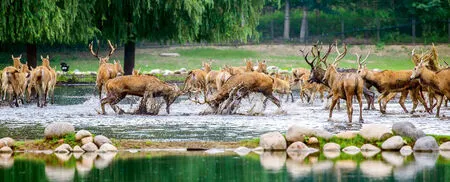Protecting Deer Wetlands
2022-06-08TextbyZhouChenliang
Text by Zhou Chenliang
On the evening of April 7, 2022, the Beijing Milu Ecological Research Center, also known as Beijing Nanhaizi Milu Park, welcomed its first baby Milu deer this year.Born in the Year of the Tiger, it was named “Luhu”(meaning “Tiger Deer”).
Based on the number of fertile adult female Milu deer in the park, researchers estimate about 40 babies will be born this year.
Milu deer, also known as Père David’s deer, is one of the world’s rare and endangered species endemic to China.Its origins can be traced back to 2 to 3 million years ago.The deer were once widely spread throughout the wetlands along the Yangtze and Yellow rivers.
The wetland deer earned the odd nickname of “”(literally, “Like none of the four”)for its unique features: a horse’s face, a donkey’s tail, cow-like hooves, and a stag’s antlers.However, its special featuresare not a result of crossbreeding but shaped by the wetland environment.

Many Milu deer live in Beijing Nanhaizi Milu Park, making it a key reintroduction site for the species.by Pan Qingquan
Zhong Zhenyu, a research fellow at the Beijing Biodiversity Conservation and Research Center, explained that the wetland is not only the habitat of Milu deer, but also their shelter.The unique wetland environment is difficult for humans and large terrestrial mammals to navigate,but easy for Milu deer.
Their hooves as big and flat as buffalos’ help them avoid sinking in the swamps.Their long tails swat mosquitoes and flies away easily.Because of their long faces, they can constantly keep their eyes above water while eating aquatic plants.

The Milu deer is a globally rare and endangered animal in the deer family.The wetland deer species got the odd nickname of “Sibuxiang”(literally, “Like none of the four”) due to its unique features: a horse’s face, a donkey’s tail, cow-like hooves,and a stag’s antlers.by Ma Yue/China Pictorial

Two great crested grebes swimming in the water.by Zhong Zhenyu

A northern red-tailed robin resting on a tree.by Zhong Zhenyu

Zhong Zhenyu, a research fellow at the Beijing Biodiversity Conservation and Research Center.by Ma Yue/China Pictorial
Wetlands in Nanhaizi
The same wetlands that host Milu deer are also closely linked to human survival and development.One of the most diversified ecological landscapes on our planet,wetlands offer an important living environment for humans too.Their ecological value earned them the nickname “kidney of Earth” as one of the three major ecological systems of our planet alongside forest and ocean.
Beijing Nanhaizi Milu Park,formerly a royal hunting garden,is located on a vast wetland created by various waterways.
The area was home to many wild Milu deer.According to historical records, the Yongding River wound around Nanhaizi,which was famous for its rich water resources and beautiful environment.So, it became a royal hunting garden and summer resort,coexisting with imperial palaces since the Liao Dynasty (907-1125).
In the Ming Dynasty (1368-1644), the royal family built a wall around the area, making it a base for the emperor to keep rare animals.The size of the enclosure was three times as big as the imperial city at that time.
The Qing Dynasty (1644-1911), especially during the reign of Emperor Qianlong, continued this tradition and carried out more water system improvement projects in Nanhaizi, which effectively avoided blockage risk due to insufficient water flow of the Grand Canal.It optimized Nanhaizi’s role in preserving water and clearing the flow, making it an important part of the north section of the canal system.
The Return of Milu Deer
In 2021, a white paper on biodiversity conservation in China particularly mentioned that the once-disappeared Milu deer in the wilds of China hadrebounded with large populations in three nature reserves—Beijing Nanhaizi Milu Park, Dafeng Milu National Nature Reserve in Jiangsu Province, and Shishou Milu National Nature Reserve in Hubei Province—with combined numbers exceeding 8,000.
From 1985 to 1987,the Chinese government reintroduced 77 Milu deer,which became the basis for the populations of Milu deer in Beijing Nanhaizi Milu Park and Dafeng Milu National Nature Reserve, kicking off China’s Milu population restoration program.
Zhong Zhenyu noted that the long-term program to help the species return included both reintroduction and rescue efforts.“Milu deer is a wetland animal,and Nanhaizi has wetlands that were artificially restored from a fishing farm,” he said.“We reintroduced them to the wetlands where their ancestors once lived, which greatly improved the success rate of reintroduction.”
The success of China’s Milu deer reintroduction project has already inspired progress in the greater global ecology.According to statistics, Beijing Nanhaizi Milu Park has kept its population steady at around 170.As the population increases, the park sends Milu deer to other places in the country to establish new populations by releasing them into the wild.
Since its establishment in 1985 as a reintroduction site for Milu deer, the park has been devoted not only to the restoration of the Milu population, but also to the protection of the wetland ecosystem.
The whole park covers more than 50 hectares, and nearly two-thirds of the area is used for Milu deer reproduction.After 37 years of ecological conservation,the park now has not only beautiful natural landscapes but also rich and diverse animals and plants.
“Alongside our signature species such as Milu deer, swans,oriental white storks, and swan geese are more than 300 other species of mammals and wild birds as well as more than 200 species of higher plants including 104 cultivated species,” said Zhong.
“The key to protecting Milu deer is protecting the wetlands,”he continued.“With Beijing’s increasing attention on improving public scientific literacy, we have added many science popularization facilities and exhibitions to help people learn about how to protect wetlands while enjoying nature.The more they know about the ecological environment, the more actively they will protect it.”

Milu deer originated in swamps in the middle and lower reaches of the Yangtze River in China and feed on grass and aquatic plants.They are gregarious and good at swimming.Their estrus begins at the end of June and lasts for about six weeks.by Pan Qingquan
